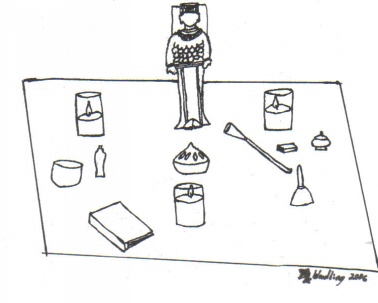
Dianic Altar

Dianic Altar
This illustration gives an example of a very basic Dianic altar. The deity here is Diana of Ephesus, the many-breasted Great Mother of fertility. Some scholars speculate she evolved from a date tree Goddess and her many breasts actually represent clusters of dates. In fact, other Goddess images or symbols could be placed here: Aradia, Isis, Artemis, Hecate, etc. The Goddess symbol could also be a spiral shell, a cowrie shell, a mirror, a crescent moon, etc.
Placed on the altar are two altar candles for illumination, located on either side of the Goddess figure. Going from left to right, there is a cup, an oil bottle, a charcoal incense burner, a candle snufter with a hinge, box of matches, container of powdered incense, and a bell. There is a notebook on the botom left next to a third votive candle. Notice all three candles are in glass chimneys for safety. It is not wise to leave burning candles unattended. The brass incense burner should be sitting on a small ceramic tile to absorb the heat and not scorch the altar cloth underneath.
Generally Wiccan and Dianic altars face north. A proper Wiccan altar, however, generally has representations of all four elements. Here, the cup is in the west (water, liquid) and the bell is in the east (air, sound).
This illustration is loosely based on diagrams in Z. Budapest's The Holy Book of Women's Mysteries Volumes I and II (1980, 1989). The altar setup also bears a striking resemblance to some types of home altars in certain folk magic systems.
This particular altar would be especially useful if you were using incense for offerings or petitions. Your prayers to the Goddess will rise on the incense smoke.